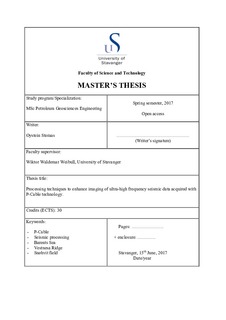| dc.description.abstract | P-Cable seismic acquisition system is a rather new technology; developed through the past 20 years. Consequently, the use of P-Cable technology has been limited, although researchers still believe that further improvements can achieve better results with this type of data. Characteristics associated with P-Cable seismic data include broad frequency bandwidth, shot offset, and low fold.
The objectives of this thesis will be to provide a processing workflow with the main goal of enhancing imaging of ultrahigh resolution P-Cable 3D seismic, acquired at Vestnesa Ridge and Snøhvit Field. This has been done by testing various methods, corresponding parameters, and through constructing a synthetic model to confirm whether improvements have been reached or not. This project differs from previous studies dealing with P-Cable 3D seismic data as it will also focus on analyzing the behavior of the synthetic model to compare the different migration techniques. The processing steps will also be considered with emphasis to aspects such as time-efficiency, resolution and geological reasoning. However, the result should ideally present images of higher resolution than previously possible to obtain with published workflows.
This work has revealed how different approaches can lead to completely different results regarding signal-to-noise ratio with similar resolution, precision in presenting accurate imaging of the subsurface, and cost-efficiency. The results have shown that noise filtered Stolt migrated data including pre-migration operation such as brute stack, F-XY deconvolution, missing data interpolation, and automatic gain control obtains good imaging with high spatial resolution and improved signal-to-noise ratio. Stolt migration also presented images with more continuous reflectors, and resolution sufficient to confidently separate features. Compared, prestack time migration constructed images of less diffraction imprint, but contained more extensive acoustic blanking and noise bursts.
The use of synthetic seismic data has shown to be useful in diagnosing properties of the different migration techniques, and for eliminating uncertainties related to velocity variation. However, results also point to independence between imaging quality of P-Cable seismic data and the input velocity model, as prestack- and reverse- time migration did not show any significant changes after applying it with constant versus actual velocity model. | nb_NO |

